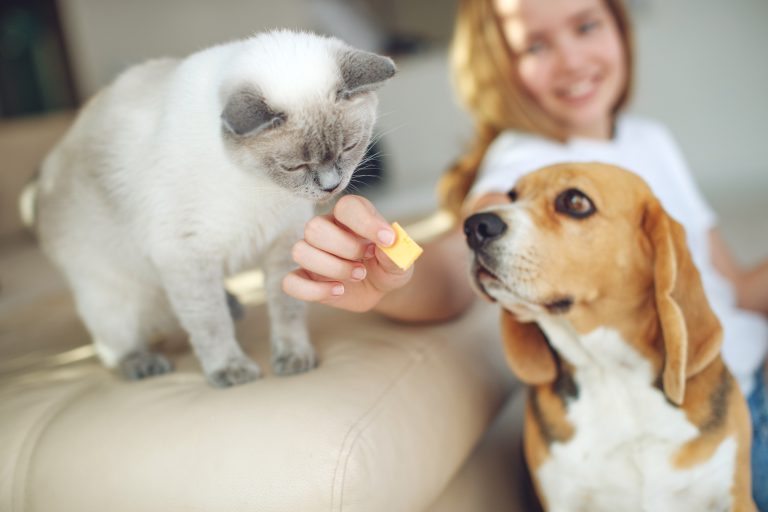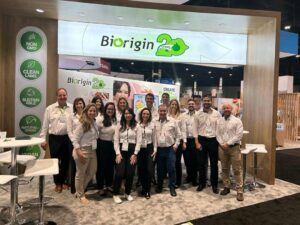In search of less loneliness and more connection, many people have found the ideal companionship in dogs and cats. According to research, 31% of pet owners in Germany report adopting a pet as a means to reduce stress¹. This is a choice that positively transforms daily routines and overall well-being.
Increasingly, pets are viewed as actual family members. In Brazil, 92% of pet owners share this view¹, while in Northern Ireland, 90% also consider their pets part of the family unit².
We are undergoing a transformation in our relationship with pets. Owners are adopting a more humanized approach, aligning the care of their animals with their own values and lifestyle.
For 61% of pet owners in the United States, the happiness and well-being of their animals are more important than their own³. This data reveals how dogs and cats occupy a special and essential place in people’s lives.
With this more affectionate and conscious perspective, it’s natural for owners to apply the same criteria to their pets that they use for themselves and their families — including when planning routines and choosing food.
Experiences become even more meaningful when shared with four-legged companions: trips, outings, and even holidays now include the special presence of pets.
These moments strengthen the bond between humans and animals, and treats play an important role in this: 81% of Brazilian consumers believe that snacks help deepen the connection with their pets⁴.
Additionally, owners seek foods that offer health benefits and come in various formats. 83% of Brazilians agree that it’s important to provide a varied diet to pets⁴. After all, different types, flavors, and textures stimulate the senses, making mealtime more enjoyable.
In this context, the pet nutrition market finds a great opportunity: to innovate in the snack and multi-format food segment, meeting the needs of pets and the emotions and expectations of their owners.
In this article, we will demonstrate how yeast extracts can be powerful allies for the pet food industry, contributing to the development of more palatable and healthy foods that align with owners’ values, such as connection, well-being, and sustainability.
THE ROLE OF YEAST EXTRACTS IN PET FOOD PALATABILITY
The palatability of pet food goes far beyond taste. It results from a combination of various sensory factors that directly influence pets’ acceptance of the food. Just as with humans, the pleasure of eating is essential to ensure that animals consume the right amount of nutrients and vitamins in an enjoyable way.
With this in mind, PalaUp by Biorigin was developed to support the pet food industry in directing flavor profiles toward specific notes, such as roasted meat and chicken, bringing pet and owner preferences even closer together. Additionally, the product line is characterized by being clean label, sustainable, and enhancing umami flavor.
The yeast extracts in the line can be applied directly in formulations or as a coating, alongside palatants, in various types of pet food — from dry extruded to wet products. This versatility allows the extracts to blend with different ingredients, creating unique and pleasant sensory experiences for pets.
Read our full article on palatability and discover how flavor influences pet nutrition and well-being.
What opportunities can the pet nutrition market explore by combining snacks with the emotional bond between owners and their pets?
TRENDS DRIVING INNOVATION IN PET TREATS
Indulgent products, such as snacks and foods that promote moments of interaction between owners and their pets, continue to gain popularity. In the United States, 63% of dog owners say they offer treats daily³.
Pet food companies can build customer loyalty by offering a greater variety of flavors and ingredients. After all, different types, flavors, and textures stimulate pets’ appetite and senses, making mealtime more enjoyable.
Moreover, these treats play a key role in pet care: they assist in training, strengthen emotional bonds with owners, and contribute to proper intake of vitamins and nutrients. Among American consumers who buy pet treats, 76% say these products strengthen their bond with their pets³.
This trend makes sense, considering that many owners see their pets as family members and are always looking to promote their four-legged companions’ happiness and well-being.
With a more humanized view of pets, it’s natural for owners to apply similar criteria to those they use when choosing food for themselves. As they become more aware of how lifestyle, diet, exercise, and mental stimulation impact pet health, they become more demanding and selective in their purchasing decisions.
For example, 27% of pet owners in Thailand say their pets’ diets reflect their own food preferences³, and 51% agree that all-natural foods would be a healthier option³.
The use of naturally sourced ingredients, such as yeast extract, is also a growing trend. In China, 47% of pet owners prioritize “all-natural” foods when repurchasing dry or wet pet food².
Meanwhile, in the United States, 34% of cat food buyers and 39% of dog food buyers consider natural ingredients an important factor in their purchasing decisions⁵.
With pet well-being in mind, interest in environmental enrichment is also on the rise. In Brazil, 50% of pet owners show interest in treats that entertain their animals⁴. The variety of treat formats allows the reward experience to be tailored to pets’ needs and preferences, making each interaction more special.
And we can go even further: families with pets enjoy including them in special celebrations, allowing them to participate in important moments. Snacks inspired by holidays — such as Easter eggs, Christmas panettone, birthday cakes, and more — help owners celebrate these occasions alongside their pets.
In summary, the pet nutrition market has numerous trends to explore that can support owners in their mission to keep pets entertained, active, and well-behaved, thereby offering more quality time and proper nutrition. But all of this must still appeal to palatability: for 43% of American cat owners and 38% of dog owners, their pet’s favorite flavor is the most important factor when making a purchase⁵.
Finally, there’s one more essential factor the pet food industry must consider when developing snacks for dogs and cats: health.
FLAVORS THAT CONNECT: THE HUMAN INFLUENCE ON PET NUTRITION
Human indulgence refers to the pursuit of pleasurable experiences, such as enjoying a favorite dessert or preparing a special meal. After all, humans are constantly seeking sensory stimuli that bring comfort and joy. With the growing humanization of pets, this same indulgence has been extended to our four-legged companions.
It’s common to see dogs and cats closely watching their owners’ plates, almost as if asking to share that moment. In this context, wet foods stand out for their convenience and ability to offer an indulgent experience. Products like creamy treats, sausages, liquid toppers (sauces for dry food), and other moist delights are clear examples of this humanization. They’re not just food — they’re gestures of affection and moments of shared pleasure and connection.
It’s no coincidence that this emotional connection between humans and pets has driven a true revolution in the pet food market, with launches increasingly resembling human food: ice cream and pasta for pets, natural meals, treats with varied shapes and flavors, gourmet-style foods, and even celebratory products for birthdays, Christmas, and other special occasions.
More than ever, pet owners want to share moments with their pets. But how can they do this while ensuring their best friend’s safety?
Ingredient origin is a key factor. For Brazilian pet owners, 91% agree that it’s important for products to clearly specify the ingredients used⁴, and 49% are concerned that unfamiliar ingredients could harm their pets⁴.
Indulgence must not come at the expense of nutrition. Keeping pets healthy is a priority, and this requires formulas that combine high-quality ingredients with strong palatability. After all, the food must appeal to the pet’s taste as well as to the owner’s eyes and nose, who seeks healthy, flavorful, and visually attractive options.
This is where Biorigin stands out with PalaUp, a food-grade ingredient — produced with the same level of quality and standards as those used in human food — developed using the same technology applied in the human food industry.
PalaUp is more than an ingredient: it’s a strategic solution to enhance the sensory perception of pet foods, delivering flavor, aroma, and visual appeal that delight even the most discerning pets and owners.
With solid expertise in producing natural-origin yeast extracts for the food industry, Biorigin applies this knowledge to create unique experiences in the pet world as well. The use of PalaUp extracts allows brands to develop indulgent products without compromising health, meeting the growing demand for foods that are both nutritious and enjoyable.
Indulgence is a bridge between emotion and function, between pleasure and care. And with solutions like PalaUp, the pet food market is well-positioned to continue delighting pet owners and their beloved companions, enabling them to share even more special moments.
BIORIGIN: NATURAL ORIGIN INGREDIENTS THAT ENHANCE PALATABILITY
The PalaUp product line intensifies umami flavor and delivers specific taste notes, such as roasted meat and chicken, bringing pet owners’ flavor preferences closer to those of their pets. As a natural source of glutamic acid, these ingredients improve the overall taste of pet food, creating an irresistible sensory profile that pets love and deserve.
“At the intersection of science and affection, we offer natural yeast extracts — widely used in the food industry — as strategic solutions for treat formulations. The PalaUp line, with a high content of free glutamic acid, enhances umami flavor and acts as a flavor driver, adding sensory and functional value to formulations that reflect the evolving relationship between humans and their pets. It also contributes to portfolio diversification by offering specific flavor notes that enrich the experience for our four-legged companions”, says Thaila Cristina Putarov, Global Animal Nutrition and Health Business Manager at Biorigin.
For over 20 years, Biorigin has been developing natural-origin ingredients to meet the demands of the pet nutrition market, offering solutions that support gut health, strengthen immunity, and increase food appeal.
To learn more about our yeast-based solutions and yeast extracts, visit our website.
Sources:
¹ Mintel – Patent insights: revolutionise the future of pet food (2024)
² Mintel – A year of innovation in pet food, 2025
³ Mintel – A year of innovation in pet food and products, 2024
4 Mintel – Pet Food – Brazil – 2025
5 Mintel – Pet Food – US – 2024






